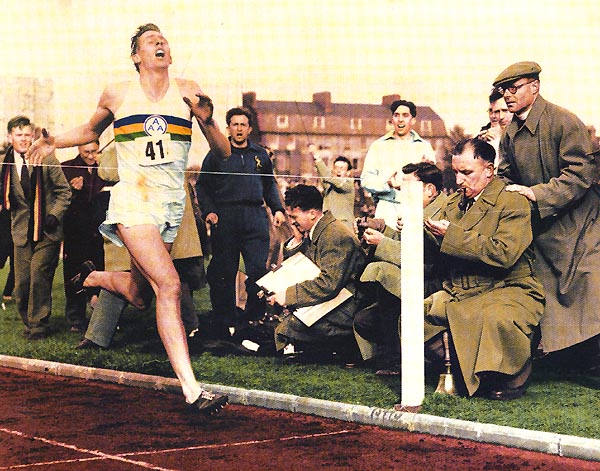In 1952 a young English runner named Roger Gilbert Bannister found himself in the 1500m final. The race was to prove one of the most dramatic in Olympic history, and the outcome was not decided until the final metres. Bannister finished a disappointing fourth. Over the next two months Bannister considered a number of dramatic changes to his training; and even the idea of giving up running altogether.
To say he was frustrated is an understatement. Ultimately, he decided on a new goal – he would run a mile in less than four minutes. At that time, nobody had ever achieved this. In fact, this was several seconds faster than the world record. Over the next couple of years he gradually took slices off his times. By the start of 1954 he was running a mile in just over 4min2secs. The day that was to change his life came in May 1954, during a meet in Oxford. In front of 3,000 incredulous spectators, Bannister ran the mile in 3min 59.4sec. He had finally done it.
A new way of thinking
The astonishing part is not just Bannister’s achievement (although that’s a big thing in itself); it’s how quickly other runners were breaking the same barrier. Just 46 days later – in a meet in Turku, Finland – Australian John Landy broke the record with a 3m57.9s . Others soon followed. This to me outlines the power of a mental barrier to limit goals; particularly when it comes to fitness. The fact that something hasn’t been done certainly doesn’t mean it can’t be done. It also highlights the importance of putting hard numbers in the goal. Whenever I’ve tried to ‘lose a few kilos‘, ‘increase my overall strength‘, ‘run without gasping for breath‘ I’ve seen slight improvements at best. Aiming to ‘lose 10kg‘, ‘deadlift 200kg‘ etc has proven far more effective.
Defining your fitness goals
Let’s face it, most of us want to change ourselves physically in some way. Lose a few pounds, add a bit of muscle; become obscenely strong. Perhaps a combination of all three. When you’re setting your fitness goals, try using Bannister’s approach. This means :
- Start with the endpoint – your ideal weight, size or the amount you’d like to lift. This is irrespective of your current state.
- Once you’ve got an idea of the target, work out how you’re going to get there. Clean up your diet, set aside some time in the home gym; whatever you need. This will give you an idea of how long it will take.
- Put some firm numbers into the goal. Aim to reach a weight of xkg, or lift ykg.
- Finally, put a date in the goal; but be flexible. In Bannister’s case, the date was defined by the times of other competitors. By the start of 1954, he knew that his available time was fast running out.
Taking away the limits
The critical part of this comes right at the beginning, when you’re first thinking about your ultimate goal. Your ideal weight, size, strength etc. By taking away the mental barriers (such as ‘I’ve never done this before‘), it’s possible to be extremely ambitious. Aim high. The benefits of doing it this way can be enormous. After all, it’s much more fun to be near a lofty goal than a conservative one. As a bonus, many of those limitations will suddenly disappear.
Final thoughts on the Bannister Approach to Goal-Setting
Roger Bannister’s unlimited, blue sky thinking can be applied to almost any bout of goal setting. However, I’ve found this method most effective when it comes to defining physical changes; such as losing weight or packing on the muscle. It’s a great way to begin any serious transformation.






I ran both cross country and track and field throughout high school and college, and the 1500 was my main event during the track season. It’s ironic that you wrote this post because although I’m already in good shape, I still feel that there’s room for improvement in my diet, rest and exercise-so I took out a couple of books on nutrition and fitness two nights ago. My point, I guess, is to say that no matter what kind of physical or mental shape you’re in, there’s always room for improvement. Setting goals is so important! Thanks :)
janelles last blog post..You Can’t Please Everyone: Five Ways to Handle Negative Comments
Roger Bannister’s story is highly inspirational! Our frame of mind can change so drastically when we’ve found that someone else have broken a previous record. It also shows how limited we can be by our minds.
Evelyn Lims last blog post..Mind Travel To Ancient Egypt
Peter – Bannister’s story is a great one and it can be applied in other area’s of life as well besides just physical conditioning. We often limit ourselves more than anyone or anything else. We have to believe something is possible before we can achieve it. Interesting article!
Jeff@MySuperChargedLifes last blog post..The Busyness and Hurriedness of Life Is Overwhelming
Hi Scott: Bannister’s story reminds me of a quote by Marianne Williamson: “And as we let our own light shine, we unconsciously give other people permission to do the same.” When someone breaks through a barrier it’s as if they’re giving others permission to do the same. And I agree that a vital part of reaching our goals is allowing ourselves mentally to do so.
Marelisas last blog post..Thoughts to Get Your Creative Juices Flowing
I definitely use limiting beliefs and when I become aware of them I either say “well that’s dumb” and get over it or I see the deepseatedness of the belief and find a workaround so that I sneak up on the limit instead of crashing through it.
Alex Fayle | Someday Syndromes last blog post..Madonna and the Success of Hypocrisy
When we convince ourselves that something can’t be done, nothing new will be done. An openness towards difference allows people to imagine, create, and accomplish.
Jason Simons last blog post..Stop! Time Alone, Time to Think, Time to Imagine
Things are created twice before they become reality. The first creation is mental creation. We think about it and imagine what success looks like. The visions we generate in our minds are the frist creation.
The second creation is physical creation. We make an action plan and work towards the goal everyday. We take actions to realize the second creation.
So if we change our thinking, we will change our results too. The story of Roger Bannister help us to understand this more: nothing is impossible. The truth is that we often limit ourselves.
Goal setting is important and it contains the two creations process.
About goal setting: http://www.goal-setting-for-success.com
Franks last blog post..Short term goal – A story tells you how to set goals
Great post! Some of the take-aways for me are:
1. Through failure we can redefine ourselves. I doubt many people know who won that Olympic race but many people know who broke the 4:00 minute mile barrier.
2. Having strong competitors makes us stronger. Knowing that others were close to achieving the same goal pushed Bannister to get there first.
3. We need goals that seem impossible to achieve. Each Individual must ultimately decide if we will do whatever it takes to succeed.
Jim
Start a New Life, Not a New Job!™ at Ex-Employee.com
You’re so right about the importance of having a big goal. If we limit ourselves only to what as been done before, there is no hope of progress or achievement.
Someone said that the problem with our dreams is that they aren’t big enough. We have to go beyond what others say is possible and beyond what we’ve ever done ourselves. That’s where greatness lies.
Thanks for sharing Bannister’s story. It gives me needed encouragement in my weight loss and personal growth plans.
Flora Morris Brown, Ph.D.s last blog post..The Simplest Kindness